Serving 360 students in grades Kindergarten-5, Horace Mann ranks in the top 30% of all schools in Massachusetts for overall test scores (math proficiency is top 30%, and reading proficiency is top 30%).
The percentage of students achieving proficiency in math is 55-59% (which is higher than the Massachusetts state average of 41%). The percentage of students achieving proficiency in reading/language arts is 55-59% (which is higher than the Massachusetts state average of 44%).
The student:teacher ratio of 11:1 is lower than the Massachusetts state level of 12:1.
Minority enrollment is 43% of the student body (majority Asian), which is lower than the Massachusetts state average of 47% (majority Hispanic).
Quick Stats (2025)
- Grades: Kindergarten-5
- Enrollment: 360 students
- Student:Teacher Ratio: 11:1
- Minority Enrollment: 43%
- Overall Testing Rank: Top 30% in MA
- Math Proficiency: 55-59% (Top 30%)
- Reading Proficiency: 55-59% (Top 30%)
- Science Proficiency: 60-64% (Top 30%)
- Source: National Center for Education Statistics (NCES), MA Dept. of Education
School Overview
Horace Mann's student population of 360 students has declined by 9% over five school years.
The teacher population of 32 teachers has stayed relatively flat over five school years.
Grades Offered
Grades Kindergarten-5
(offers virtual instruction)
(offers virtual instruction)
Total Students
360 students
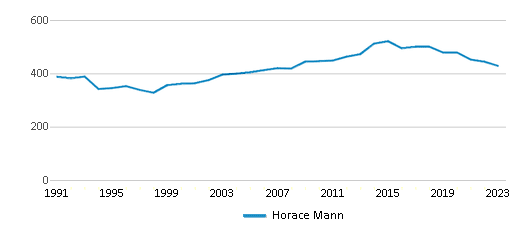
Gender %
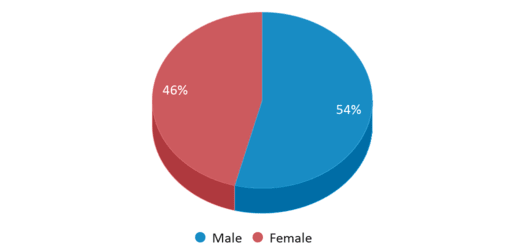
Total Classroom Teachers
32 teachers
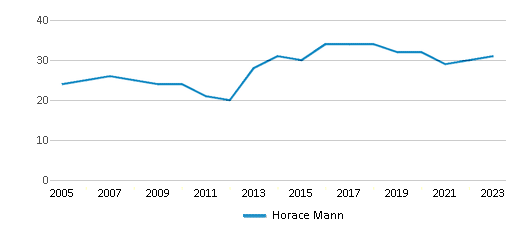
Students by Grade
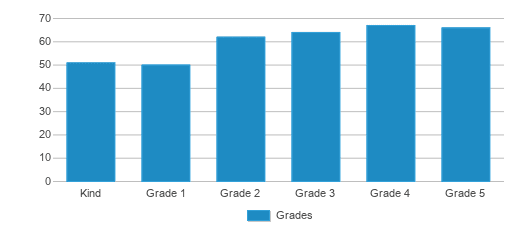
School Rankings
Horace Mann ranks within the top 30% of all 1,631 schools in Massachusetts (based off of combined math and reading proficiency testing data).
The diversity score of Horace Mann is 0.63, which is less than the diversity score at state average of 0.65. The school's diversity has stayed relatively flat over five school years.
Overall Testing Rank
#388 out of 1631 schools
(Top 30%)
(Top 30%)
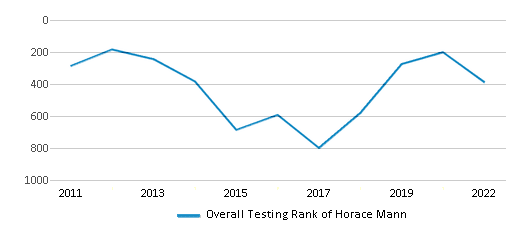
Math Test Scores (% Proficient)
55-59%
41%
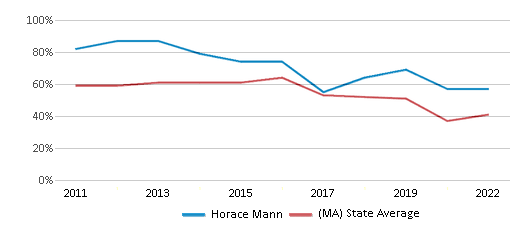
Reading/Language Arts Test Scores (% Proficient)
55-59%
44%
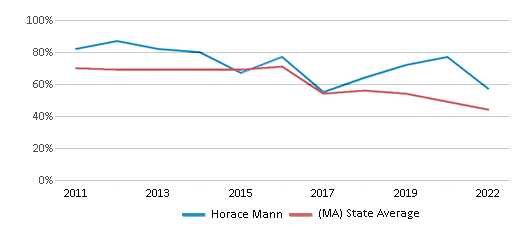
Science Test Scores (% Proficient)
60-64%
44%
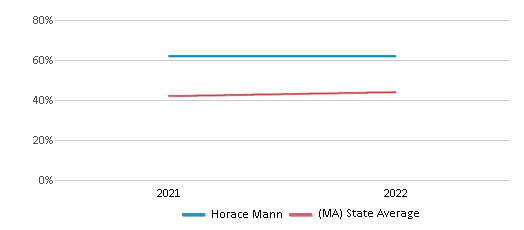
Student : Teacher Ratio
11:1
12:1
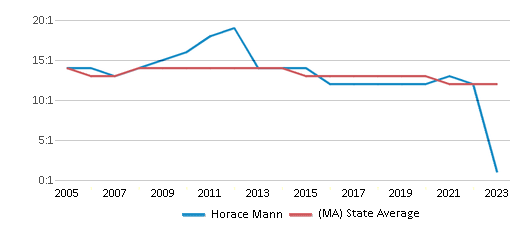
American Indian
n/a
n/a
Asian
16%
7%
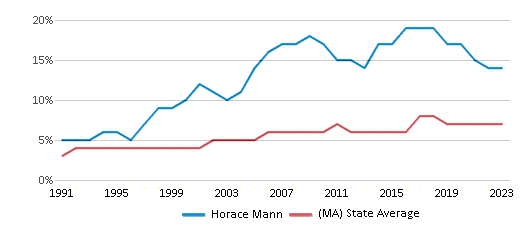
Hispanic
10%
25%
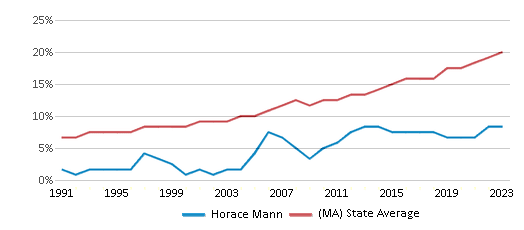
Black
5%
10%
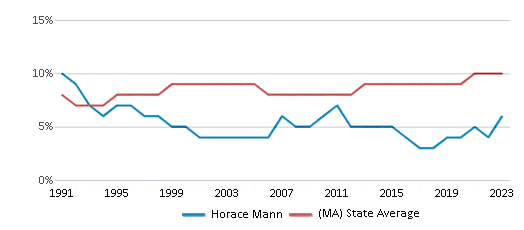
White
57%
53%
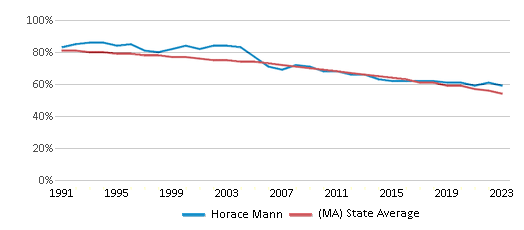
Hawaiian
n/a
n/a
Two or more races
12%
5%
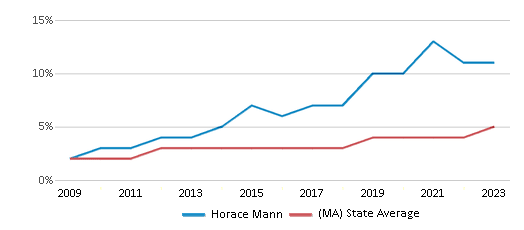
All Ethnic Groups
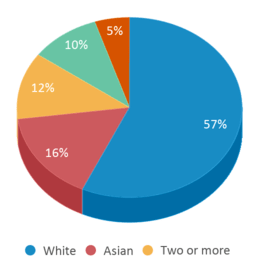
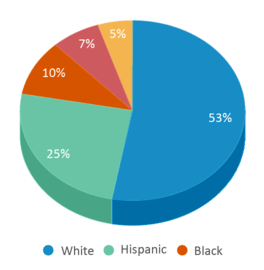
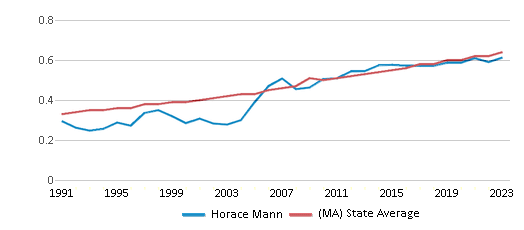
Participates in the National School Lunch Program (NSLP)
Yes
Eligible for Free Lunch
19%
35%
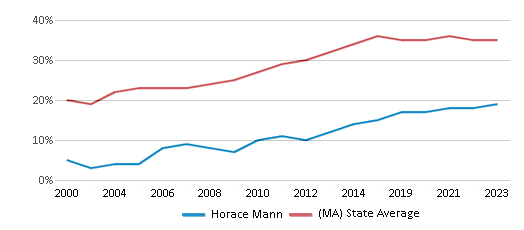
Eligible for Reduced Lunch
2%
4%
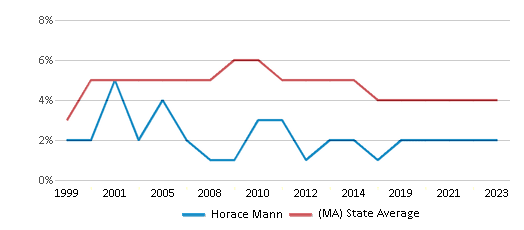
School Statewide Testing
School District Name
Source: National Center for Education Statistics (NCES), MA Dept. of Education
Profile last updated: 02/09/2025
Frequently Asked Questions
What is Horace Mann's ranking?
Horace Mann is ranked #388 out of 1,631 schools, which ranks it among the top 30% of public schools in Massachusetts.
What schools are Horace Mann often compared to?
Horace Mannis often viewed alongside schools like Cabot, Lincoln-eliot by visitors of our site.
What percent of students have achieved state testing proficiency in math and reading?
55-59% of students have achieved math proficiency (compared to the 41% MA state average), while 55-59% of students have achieved reading proficiency (compared to the 44% MA state average).
How many students attend Horace Mann?
360 students attend Horace Mann.
What is the racial composition of the student body?
57% of Horace Mann students are White, 16% of students are Asian, 12% of students are Two or more races, 10% of students are Hispanic, and 5% of students are Black.
What is the student:teacher ratio of Horace Mann?
Horace Mann has a student ration of 11:1, which is lower than the Massachusetts state average of 12:1.
What grades does Horace Mann offer ?
Horace Mann offers enrollment in grades Kindergarten-5 (offers virtual instruction).
What school district is Horace Mann part of?
Horace Mann is part of Newton School District.
In what neighborhood is Horace Mann located?
Horace Mann is located in the Nonantum neighborhood of Newtonville, MA. There are 1 other public schools located in Nonantum.
School Reviews
1 6/20/2022
3 kids through this school. Loved the teachers, the principal, and after school program.
2 3/8/2010
Don't send your kids to this school!! The quality of the education there is terrible!! Kids get a whole bunch of free time every day, and the teachers teach almost nothing. Besides, some teachers are very mean to kids, particularly one in kindergarten and one in first grade. They are both awful. As parents, we were so disappointed about their education quality. Also, our child was so unhappy with the school.
Our helplessness and the very lousy experiences with the school made us to decide that we want our child to transfer to another school. After some researches, we moved the entire family to another school district. Now, we know how far it is for this school to be qualified as a good school. Now we are happy that we've made a right decision!! No more fear, anger, and helplessness in the new school!!
Review Horace Mann. Reviews should be a few sentences in length. Please include any comments on:
- Quality of academic programs, teachers, and facilities
- Availability of music, art, sports and other extracurricular activities
Recent Articles

What Is A Charter School?
Explore the world of charter schools in this comprehensive guide. Learn about their history, how they operate, and the pros and cons of this educational innovation. Discover key facts about charter schools, including admission policies, demographics, and funding, as well as what to look for when considering a charter school for your child.

10 Reasons Why High School Sports Benefit Students
Discover the 10 compelling reasons why high school sports are beneficial for students. This comprehensive article explores how athletics enhance academic performance, foster personal growth, and develop crucial life skills. From improved fitness and time management to leadership development and community representation, learn why participating in high school sports can be a game-changer for students' overall success and well-being.

February 05, 2025
Understanding the U.S. Department of Education: Structure, Impact, and EvolutionWe explore how the Department of Education shapes American education, from its cabinet-level leadership to its impact on millions of students, written for general audiences seeking clarity on this vital institution.





